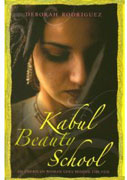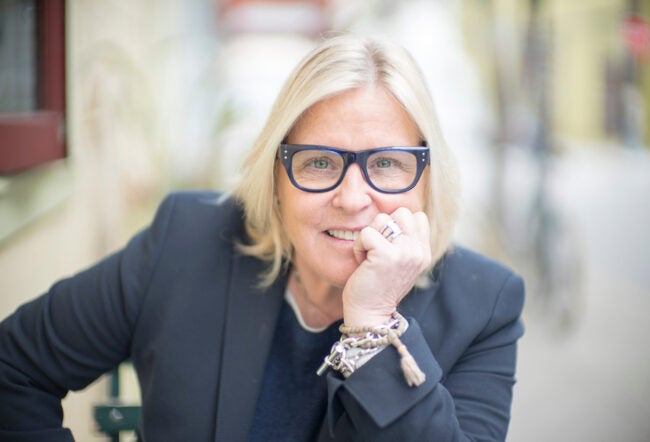In one of the more memorable scenes in Kabul Beauty School: An American Woman Goes Behind the Veil, author Deborah Rodriguez teaches a group of Afghan beauty students the rules for dying hair. Struggling to convey the principles of the color wheel across linguistic and cultural differences, Rodriguez nearly gives up: “After three days of class, they just look at me like I’m speaking Greek,” she complains to a friend. “I don’t think I’m going to be able to teach them anything.” The friend urges patience, and a chastened Rodriguez, alive to the difficulties of her students’ chaotic lives, tries again.
“The next day, I had a breakthrough,” she writes. “I was trying one more time to get across the idea of the contributing pigment as something you had to counteract in order to get the color right. They were all looking at me with courteous incomprehension — blank if benign stares — and I was groping around for an analogy. ‘Think of it as Satan!’ I finally said, pointing at a patch of orange paint. ‘It’s the evil thing in your hair that you have to fight. You have to use the opposite color to keep it from taking over.'”
The analogy works. A student’s face lights up with understanding. She gets hugged and kissed by Rodriguez and then explains the principle of pigment counteraction to her fellow students. Soon, the class is humming with excitement. “I’d whip questions at them — éélike ‘You’ve got a woman who’s a natural level four and she wants to be a warm eight, so what do you do?’ — and they’d whip the answers right back at me.”
Rodriguez tells this story to describe the difficulties she faced launching a beauty school in post-Taliban Kabul. But the story also serves as a tongue-in-cheek parable for the challenge of explaining to a Western audience what it’s like to try to launch a business in a place as war-torn and uncertain as Afghanistan. Faced with finding a way to talk about her experiences that will be recognizable to an audience unfamiliar with Afghan life, Rodriguez does with her story what she does with hair: She creates a unique effect by creatively combining stock components.
Stories, like hair colors, frequently follow formulas. Two distinct narrative formulas come together in Kabul Beauty School.
First, there is the sensitive exposé of “life behind the veil.” From Reading Lolita in Tehran, Azar Nafisi’s award-winning account of an underground Iranian women’s book group, to The Kite Runner, Khaled Hosseini’s best-selling novel about modern Afghanistan, tales of Islamic culture have entranced Western readers eager for a glimpse into a world that is at once far removed from theirs and yet fundamentally intertwined with it. Kabul Beauty School opens a window onto the private lives of Afghan women, whose beauty secrets and hidden histories are both revealed in the course of the book.
The second formula at work in Rodriguez’s book is the beauty shop saga. Anchoring such movies as Steel Magnolias (1989), Legally Blonde (2001), and Queen Latifah’s more recent Beauty Shop (2005), to name a few, the beauty shop saga treats the salon as the scene of an all-female utopia that transcends the social and cultural differences that divide women in the world beyond the shop. This effect is intensified in Kabul Beauty School, as the beauty shop is just about the only place in Afghanistan where women can freely gather.
A beauty shop saga that takes place behind the veil, Kabul Beauty School is a business memoir with attitude, a warm, insightful and strikingly sharp account of what it’s like to try to launch and run an NGO in a remote and unsettled part of the world.
In the spring of 2002, shortly after the fall of the Taliban, Rodriguez flew to Kabul with an emergency relief operation organized by the Care for All Foundation. As a hairdresser, she was the odd woman out amid the volunteer doctors, dentists, midwives and nurses who surrounded her. At first, she struggled to make herself useful, and her exploratory forays into the restless city streets — which she conducted with her spiky red hair uncovered, and which revealed her special genius for bonding with Afghan strangers — frightened her colleagues so much that they assigned her the “job” of staying home and praying for them. But when word got out that an actual hairdresser had come to Kabul, Rodriguez became an overnight celebrity within the sizable population of Westerners doing relief work in Afghanistan. People started lining up outside her door for haircuts, and it wasn’t long before she was doing the locals’ hair as well.
Without knowing it, Rodriguez had brought with her to Afghanistan skills that offered just as much as those of the medical personnel on her relief team. Everyone in Kabul, it seemed, was desperate for a good haircut. And Rodriguez quickly realized that hairdressing had the potential to help revitalize the Afghan economy by enabling women to become wage earners in a socially acceptable way.
The Taliban had shut down Kabul’s once thriving beauty industry. Some women had continued to do hair at home, and many counted the wives of Taliban men among their clients. But this was an underground economy run by women who were largely unschooled in the finer points of cutting, coloring, perming and styling hair — not to mention basic hygiene (one of Rodriguez’ Western clients describes catching lice during a visit to a local hairdresser). As amateurish as they were — “they were using 10-year-old perm solution and scissors the size of hedge clippers” — these women made good money, often earning several times what their husbands made at their jobs. Crucially, they did so at work that men did not find threatening.
The potential, Rodriguez recognized, was enormous. “I had discovered the one thing I could do to help the Afghans,” many of whom were uneducated and impoverished, she says. That was to “help them run better salons and make more money. I knew from my own experience back home that a salon is a good business for a woman.”
As so often happens with great ideas, Rodriguez was not the only person to have this one. Asking around, she quickly discovered that others were already well on their way to launching a beauty school in Kabul. Seeded with donations from Vogue and Estee Lauder, an NGO known as PARSA (Physiotherapy and Rehabilitation Support for Afghanistan) had created a program named Beauty Without Borders; its special purpose was to found a beauty school in Kabul. Rodriguez volunteered to be an instructor in the school, and returned to Kabul with a truckload of hair products and cosmetics donated by Paul Mitchell, M.A.C., and others.
The story of the Kabul Beauty School’s first course has already been told. Beauty Academy of Kabul, a 2003 documentary made by independent filmmaker Liz Mermin, follows Rodriguez and the school’s other founding teachers as they prepare the classrooms (safely tucked inside the Afghan Ministry of Women’s Affairs compound), select the students, train and test them, and graduate them at a gala ceremony held at the local Turkish restaurant. It is a touching film, but, as a chronicle of the Kabul Beauty School, it is an incomplete one. What happens after the first class graduates — and the teachers go home, and the cameras are gone, and the funding dries up — is the real subject of Rodriguez’s book.
Aware of the first principle of good management — that someone should always be minding the store — Rodriguez worries from the outset about the Beauty Without Borders business model. As a program affiliated with by a non-profit foundation, Beauty Without Borders was not being run in a business-like way: It had no reliable income stream, it did not have a full-time manager, and it ran up exorbitant costs flying teachers back and forth between Kabul and their homes in the U.S. Recognizing that the school will fail if all the teachers simply exit the country every time a course is completed, Rodriguez envisions the school maintaining a full-time teaching and administrative presence in Kabul, and she also pictures it becoming self-sufficient by training Afghan women to be teachers as well as stylists.
Rodriguez decides to move to Kabul to run the school full time. And she does what she must to ensure the school’s success. When the funding for the second class is suddenly cut, Rodriguez opens a chic salon and uses the proceeds to finance the school. When the Afghan Ministry for Women suddenly shuts the school down — claiming, among other things, that too much laughter could be heard outside — Rodriguez re-opens it elsewhere and assumes responsibility for the inflated rent local landowners impose on foreign NGOs. When the government tries illegitimately to shake the school down for back taxes, Rodriguez pays the expected bribe to expunge the charges and protect the school from ruin. When the terrorists living next door report her to the police for “immorality” (claiming she stood naked on her balcony, a charge she hotly denies), she helps the police run a sting operation to take them into custody.
All the while, the school thrives.
Rodriguez expands the mission of the school, building business lessons into the curriculum. “I figured they would better develop business skills if they learned how to be managers,” she writes. The lessons are necessary, and hard-won: “Most of them didn’t have much experience with making decisions. It seemed to hurt their pride to have to think about mundane matters such as power and water or to make sure the floors around the stations and the product shelves were clean.” She also teaches students to make financial decisions. “I presented them with a chunk of money at the beginning of the term. They would be in charge of buying whatever the school needed, like hand soap or new towels. All I wanted them to do was keep track of the receipts.” By the time the fourth beauty school class matriculates, Rodriguez’ system of delegated authority is firmly in place. “I told them not to call me unless the building was burning down. I told them they could handle everything else, and they did.”
Along the way, Rodriguez cuts costs without sacrificing quality, and she adapts the curriculum to allow graduates to better meet their clients’ needs. The original beauty school class had been very Western in orientation; the unit on makeup had been all but unintelligible to women who prefer elaborate, heavy makeup, not the light, natural look Westerners cultivate. Rodriguez adjusts her makeup instruction to accommodate Afghan ideals of beauty, and she also encourages her students to develop their own hair and makeup aesthetics.
It hardly needs saying that Kabul Beauty School is not your typical managerial how-to manual. Rodriguez is a hairdresser, and she doesn’t pretend otherwise. Light on managerial advice and heavy on personal anecdotes, the book doesn’t offer orderly tips on organizing and funding third world non-profit initiatives in the manner of, say, John Wood’s Leaving Microsoft to Change the World. Disguising a serious story about the economic and social reclamation of post-Taliban Afghanistan as a chatty series of stories about hair, makeup, and the troubled lives of the school’s students, Rodriguez adopts the guise of what one might call an “accidental entrepreneur.” She stumbles onto the idea of a school, and then stumbles onto the realities of financing the venture. Nothing goes according to plan in Kabul, and the rules, when there are any, are unwritten and non-Western. Had Rodriguez had a how-to guide, she could not have used it. Had she tried to write one, the result would have been laughably far removed from reality.
Even so, the success of the Kabul Beauty School speaks for itself. Graduates do so well that they typically raise their families’ incomes 400%.
And out of the chaotic process of trying to keep a foundering but essential enterprise afloat, Rodriguez develops an immensely compelling business plan. By the time she wrote her book in 2006, a mere three years after the Beauty Without Borders program began, the Kabul Beauty School was solidly bankrolled by Rodriguez’s Oasis Salon, which functioned, in turn, as an integral part of the training program by allowing graduates to further hone their skills as well as train to be teachers in the school.
The trouble with the sort of creative entrepreneurial brinkmanship Rodriguez employed, however, is that its secrets cannot be shared without risk. Since Random House published Kabul Beauty School in April, the book has rocketed up the New York Times bestseller list, and Sony Pictures is planning a film starring Sandra Bullock. But it has also caused quite a stir back in Kabul, where word of the book has leaked out, and where the women whose stories of loss, abuse, and hardship figure in the book say they now fear for their lives.
The fears are well grounded. The beauty school’s teachers and the students have been threatened with guns, accused of “defaming” Afghanistan. And when Rodriguez returned to Afghanistan in May, her own safety was so uncertain that she was not permitted to stay.
Rodriguez has promised to share her book royalties with the women who appear in the book, and will also be giving them 5% of her earnings from the film. But this might be one business plan that does not cover its costs.



